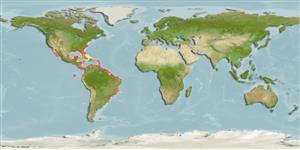Environment: milieu / climate zone / depth range / distribution range
Ecologia
marino; salmastro demersale; oceanodromo (Ref. 51243); distribuzione batimetrica 0 - 100 m (Ref. 115829), usually 0 - 30 m (Ref. 5217). Subtropical; 11°C - 31°C (Ref. 47167); 40°N - 34°S, 117°W - 34°W
Eastern Central Pacific: Baja California to Peru (Ref. 9330); Northwestern Central Atlantic: Canada (Ref. 5951) to Chesapeake Bay, USA to the Antilles and southern Brazil.
Length at first maturity / Size / Peso / Age
Maturity: Lm 8.5, range 8 - ? cm
Max length : 22.4 cm TL maschio/sesso non determinato; (Ref. 131022); common length : 15.0 cm TL maschio/sesso non determinato; (Ref. 5217); peso massimo pubblicato: 117.40 g (Ref. 131022); Età massima riportata: 1.21 anni (Ref. 47359)
Spine dorsali (totale) : 0; Raggi dorsali molli (totale) : 73 - 87; Spine anali: 0; Raggi anali molli: 57 - 68.
Inhabits sandy and muddy bottoms (Ref. 9330). Common in estuaries (Ref. 9330). Feeds on big, benthic invertebrates and small fishes (Ref. 9330). Utilized fresh (Ref. 9330).
Life cycle and mating behavior
Maturità | Riproduzione | Deposizione | Uova | Fecundity | Larve
Oviparous (Ref. 101737). Distinct pairing (Ref. 205). Females produce numerous eggs in multiple spawnings during a prolonged spawning period (Ref. 101737).
Figueiredo, J.L. and N.A. Menezes, 2000. Manual de peixes marinhos do sudeste do Brasil. VI.Teleostei (5). Museu de Zoologia, Universidade de São Paulo. Brazil. 116 p. (Ref. 36453)
IUCN Red List Status (Ref. 130435: Version 2024-1)
Threat to humans
Harmless
Human uses
Pesca: scarso interesse commerciale
Strumenti
Special reports
Download XML
Fonti Internet
Estimates based on models
Preferred temperature (Ref.
123201): 21.1 - 28, mean 25.7 °C (based on 862 cells).
Phylogenetic diversity index (Ref.
82804): PD
50 = 0.5020 [Uniqueness, from 0.5 = low to 2.0 = high].
Bayesian length-weight: a=0.00832 (0.00660 - 0.01048), b=3.10 (3.03 - 3.17), in cm total length, based on LWR estimates for this species (Ref.
93245).
Trophic level (Ref.
69278): 3.5 ±0.1 se; based on diet studies.
Generation time: 2.4 ( na - na) years. Estimated as median ln(3)/K based on 2
growth studies.
Resilienza (Ref.
120179): Alto, tempo minimo di raddoppiamento della popolazione meno di 15 mesi (tmax=1.2; k >0.3).
Fishing Vulnerability (Ref.
59153): Low vulnerability (11 of 100).
Nutrients (Ref.
124155): Calcium = 191 [89, 438] mg/100g; Iron = 1.64 [0.75, 3.24] mg/100g; Protein = 17.7 [15.6, 19.8] %; Omega3 = 0.244 [0.120, 0.523] g/100g; Selenium = 36.6 [16.0, 86.1] μg/100g; VitaminA = 4.61 [1.15, 21.44] μg/100g; Zinc = 1.06 [0.66, 1.63] mg/100g (wet weight);
